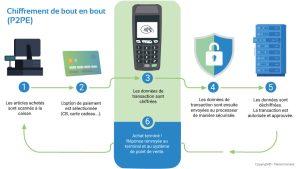P2PE: Data Security at the Heart of Transactions
Data security is a major concern, especially when it comes to financial transactions, and it is essential to put in place robust security measures to protect sensitive information.

What is P2PE?
PP2PE, or Point-to-Point Encryption, is an encryption technology established by the PCI Security Standards Council. Its aim is to secure sensitive data exchanged during electronic transactions. It protects customers’ personal, financial and confidential information by encrypting it from its point of origin to its final destination.
How does the P2PE solution work?
Essentially, P2PE encrypts the card information as soon as it is taken from the payment processor. To do this, an algorithm transforms the information into an unreadable code. When an electronic transaction is carried out, the information is encrypted at the initial point of interaction, such as a payment terminal or secure website. First, this code is transferred to the payment processor. It is then decrypted using a secure key that enables the data to be processed securely. Since the decryption is done electronically, the merchant never comes into contact with his customers information.
In short, this solution considerably reduces the risk of fraud and theft of confidential information. By encrypting sensitive data at the point of origin, P2PE makes it virtually impossible for malicious third parties to intercept or exploit it. This guarantees the confidentiality and integrity of buyers’ personal information.
Benefits of P2PE:
- Improved transaction security by providing increased protection against cyber attacks and data breaches;
- Simplified compliance: enables compliance with security standards such as PCI DSS.

To find out more: contact us!